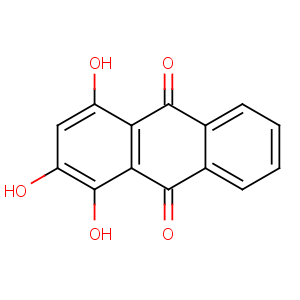Title: Purpurin
CAS Registry Number: 81-54-9
CAS Name: 1,2,4-Trihydroxy-9,10-anthracenedione
Synonyms: 1,2,4-trihydroxyanthraquinone; C.I. Natural Red 8; C.I. Natural Red 16; C.I. 58205; C.I. 75410
Molecular Formula: C14H8O5
Molecular Weight: 256.21
Percent Composition: C 65.63%, H 3.15%, O 31.22%
Literature References: Occurs as glycoside in the madder root
(Rubia tinctorum L.,
Rubiaceae) of commerce. Is formed during storage; no appreciable amount in the fresh root: Hill, Richter,
J. Chem. Soc. 1936, 1714. Although a dye itself, it is usually considered as an undesirable contamimant of alizarin extracted from madder. May be prepd from alizarin by oxidation with ammonium persulfate: Wacker,
J. Prakt. Chem. [2]
54, 90 (1896); also by Friedel-Crafts condensation of hydroxyhydroquinone with phthalic anhydride: Dimroth, Fick,
Ann. 411, 321 (1916).
Properties: Long orange needles with 1 H2O from dil alcohol, anhydr at 100°. Anhydr red needles from abs alcohol or by sublimation around 150° in high vacuum (less than 2 mm Hg). mp 257°. Absorption spectrum: Meek,
J. Chem. Soc. 111, 969 (1917); Ezaby,
ibid. (B) 1970, 1293. More sol in boiling water than alizarin (yellow color with yellowish hue). Freely sol in alcohol (red), in ether (intensely yellow with fluorescence). Soluble in benzene, toluene, xylene (dark yellow), in boiling alum soln (red).
Melting point: mp 257°
Derivative Type: 2-Methyl ether
Molecular Formula: C15H10O5
Molecular Weight: 270.24
Percent Composition: C 66.67%, H 3.73%, O 29.60%
Properties: Orange crystals from benzene, mp 240°.
Melting point: mp 240°
Derivative Type: 2,4-Dimethyl ether
Molecular Formula: C16H12O5
Molecular Weight: 284.26
Percent Composition: C 67.60%, H 4.26%, O 28.14%
Properties: Orange needles, mp 186-189°.
Melting point: mp 186-189°
Use: Forms colored "lakes" with various metal salts and is a fast dye for cotton printing. Now used mostly in the manuf of acid and chrome dyes. Reagent for the detection of boron; for detection of insol calcium salts in the cell contents of histological material and as a nuclear stain.

